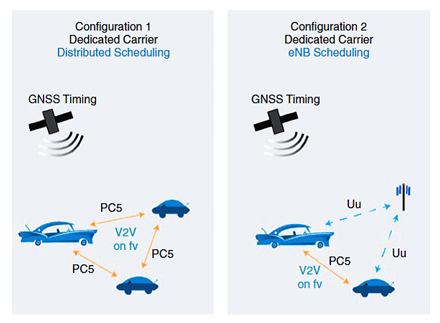|
The Third Generation Partnership Project (3GPP) has
developed some functionalities to provide enhancements of cellular
standards specifically for vehicular communications. These include both
direct communication (between vehicles, vehicle-to-pedestrian, and
vehicle-to-infrastructure) and cellular communications with networks.
The vehicle-to-vehicle (V2V) work item builds on
earlier work on device-to-device (D2D) communications and introduces a new
D2D interface (designated as PC5, which is also known as the sidelink at
the physical layer), specifically addressing communications at vehicular
speeds.
To that end, four additional pilot symbols have been
added to the demodulation reference signal to allow for better tracking
of the channel despite high Doppler effects associated with relative
speeds of up to 500 km/h and at high frequency (with 5.9 GHz ITS band
being the main target).
Furthermore, a new arrangement of scheduling
assignment and data resources has been established with the goal of
enhancing the system-level performance under high density while
meeting the latency requirements of V2V use cases.
Finally, distributed scheduling (in other words,
Mode 4) allows direct V2V communications without introducing a
detour through the base station, which uses a mechanism based on
sensing with semipersistent transmission (Figure 1).

Figure 1. In (a), the
scheduling and interference management of V2V traffic is supported based on
distributed algorithms (Mode 4) implemented between the vehicles, whereas in
(b), it is assisted by the base station (Mode 3). GNSS: Global
Navigation Satellite System; eNB: evolved Node B. (Image courtesy of 3GPP.)
In addition, a new mechanism where
resource allocation is dependent on geographical information is
introduced. Such a mechanism counters the near–far effect that is
due to in-band emissions. The initial Cellular Vehicle-to-Everything
(V2X) standard focuses on V2V communications with further enhancements
to support additional V2X operational scenarios that will follow, and
this standard targets completion during March 2017 in Release 14.
Full article: IEEE
Vehicular Technology Magazine, Volume 12, Number 1, March 2017 |